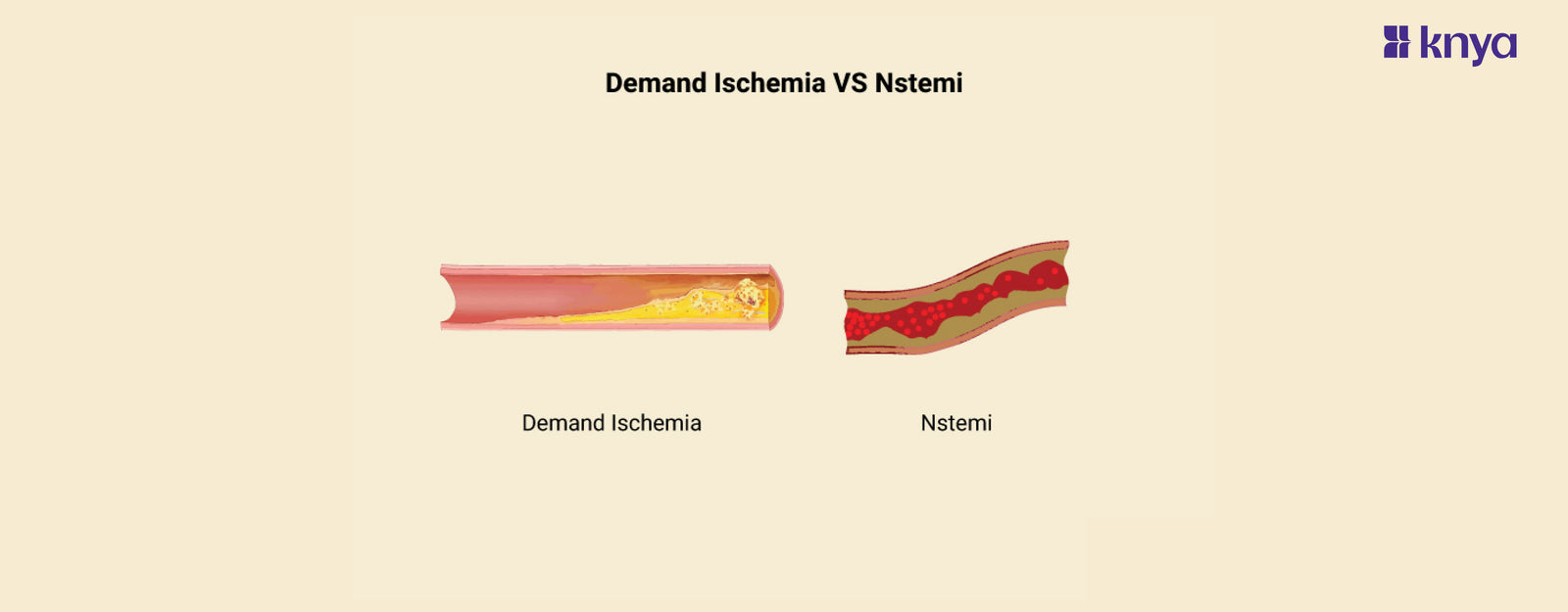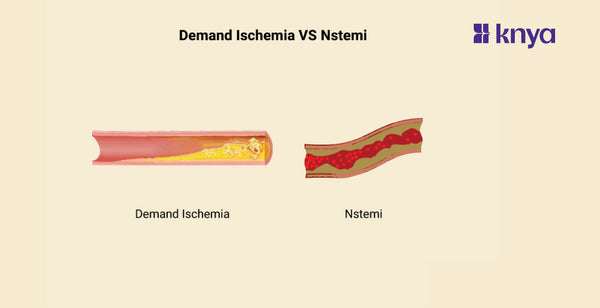Difference between Demand Ischemia vs NSTEMI:An imbalance between myocardial oxygen supply and demand, which frequently occurs during physical activity or stress, can result in Demand Ischemia. This imbalance can cause brief episodes of Ischemia, which are shown on the ECG as T-wave inversion or ST-segment depression. In contrast to NSTEMI, it entails less myocardial damage and is treated by treating underlying causes and symptom relief with drugs like nitroglycerin. Because of the severe myocardial damage caused by NSTEMI, intensive care is necessary. This includes antiplatelet therapy, anticoagulation, and even invasive procedures.
Demand Ischemia
- Result of an imbalance that occurs during physical activity or stress between the supply and demand of oxygen in the heart.
- Causes temporary ischemia, which manifests on an ECG as T-wave inversion or ST-segment depression.
- Mildly increased or normal cardiac biomarkers, indicating minimal myocardial damage.
- Controlled by treating the underlying causes and using drugs like nitroglycerin to relieve symptoms.
NSTEMI
- NSTEMI is a form of heart attack characterized by myocardial damage but no substantial ST-segment elevation on the ECG.
- Chest pain or discomfort that does not go away with rest or nitroglycerin is one of the symptoms.
- Elevated cardiac biomarkers that signify myocardial damage are necessary for the diagnosis.
- Aggressive antiplatelet therapy, anticoagulation, and even invasive procedures are all part of the management.
Difference between Demand Ischemia and NSTEMI
Demand Ischemia results from brief ischemic episodes, which are detected by ECG abnormalities when myocardial oxygen demand increases above supply during physical activity or stress. NSTEMI, on the other hand, usually requires aggressive care techniques since it manifests with myocardial damage without considerable ST-segment elevation and is usually accompanied by chest pain at rest or with modest exercise. The table below shows the differences between Demand Ischemia and NSTEMI.
|
Aspect |
Demand Ischemia |
NSTEMI |
|
Definition |
Ischemia occurring due to increased oxygen demand, often during physical exertion or stress |
Non-ST-segment elevation myocardial infarction (NSTEMI) is a type of heart attack where there is evidence of myocardial injury without significant ST-segment elevation on ECG |
|
Underlying Causes |
Increased myocardial oxygen demand exceeding supply, typically due to physical exertion, stress, or other factors increasing cardiac workload |
Acute obstruction of a coronary artery leading to reduced blood flow to a portion of the myocardium, often due to plaque rupture or erosion |
|
ECG Findings |
ST-segment depression or T-wave inversion, often transient and occurring during stress or exertion |
Absence of significant ST-segment elevation, but may present with ST-segment depression or T-wave inversion, indicating myocardial injury |
|
Cardiac Biomarkers |
Typically normal or minimally elevated troponin levels, reflecting reversible myocardial ischemia without necrosis |
Elevated troponin levels, indicating myocardial injury and necrosis |
|
Clinical Presentation |
Chest discomfort or angina-like symptoms typically triggered by exertion or stress, which resolves with rest |
Chest pain or discomfort often at rest or with minimal exertion, lasting longer than 20 minutes and not fully relieved by rest or nitroglycerin |
|
Management |
Treatment focuses on addressing underlying causes of increased myocardial oxygen demand, optimizing cardiovascular risk factors, and relieving symptoms with nitroglycerin or other antianginal medications |
Requires aggressive management including antiplatelet therapy, anticoagulation, and potentially invasive procedures such as coronary angiography and revascularization |
Browse The Best Scrubs Collection!
What is Demand Ischemia?
Demand Ischemia is the temporary periods of inadequate blood flow that result from the heart's requirement for more oxygen than it can give. This usually causes chest pain and reversible abnormalities in the ECG. Demand Ischemia happens during physical activity or stress.
Features of Demand Ischemia
- Occurs when there is a greater demand for oxygen by the heart, like in the case of physical activity or stress.
- Appears as brief periods of insufficient blood supply to the cardiac muscle.
- Usually manifests as angina pectoris, or chest pain or discomfort.
- Frequently accompanied by abnormalities in the electrocardiogram (ECG), such as T-wave inversion or ST-segment depression.
- Is reversible as soon as the oxygen demand returns to normal and the triggering action stops.
Causes of Demand Ischemia
- Physical Exertion: Exercise and other activities that put more strain on the heart can raise oxygen demand and cause demand ischemia.
- Emotional Stress: Stressful circumstances may also increase the oxygen that the heart needs to function, which may lead to demand ischemia.
- Hyperthyroidism: Disorders such as hyperthyroidism can raise myocardial oxygen demand and quicken heart rate, which can lead to demand ischemia.
- Anemia: When there is a surge in demand, the heart muscle may not receive enough oxygen due to the blood's decreased ability to carry oxygen.
- Coronary Artery Disease: People who have underlying coronary artery disease are more likely to experience demand ischemia because their heart's capacity to respond to elevated oxygen demands is compromised.
- Hypertension: Especially when physical activity is involved, high blood pressure can raise oxygen demand and myocardial strain, which may lead to demand ischemia.
Symptoms of Demand Ischemia
- Weakness or exhaustion.
- Vomiting or nausea.
- Perspiration.
- Feeling lightheaded or dizzy.
- Chest pain or discomfort, frequently characterized as tightness, pressure, or squeezing.
- The neck, jaw, shoulders, arms, or back may all experience radiating pain.
- Breathlessness.
What is NSTEMI?
An ECG with myocardial damage but no discernible ST-segment elevation is known as non-ST-segment elevation myocardial infarction, or NSTEMI. It usually arises from intermittent or partial blockage of a coronary artery, which causes myocardial ischemia and damage as a result of decreased blood flow to a section of the heart muscle. Medication to increase blood flow and decrease clot formation is part of the treatment, as is the use of procedures like coronary angiography and perhaps stenting to restore blood flow to the damaged heart region.
Features of NSTEMI
- Electrocardiogram (ECG) showing signs of myocardial damage without appreciable ST-segment elevation.
- Elevated cardiac biomarkers that signify myocardial injury, such as troponin.
- Usually appears with symptoms of chest pain or discomfort, which are usually best eased by rest or nitroglycerin and last longer than 20 minutes, either while at rest or with little effort.
- Has to be evaluated and treated by a doctor right away to stop further cardiac problems and damage.
- In addition to procedures like coronary angiography and potential stenting to restore blood flow to the damaged part of the heart, management includes taking drugs to enhance blood flow and prevent clot formation.
Causes of NSTEMI
- Atherosclerosis: The most frequent cause of NSTEMI is atherosclerosis. When fatty deposits, known as plaques, accumulate in the arteries, the arteries narrow and the heart's blood flow is reduced. This condition is known as atherosclerosis.
- Coronary Artery Spasm: Occasionally, the coronary arteries may constrict or spasm, which lowers the amount of blood that reaches the heart muscle. This can happen even if there isn't much plaque accumulation.
- Coronary Artery Embolism: The heart's blood supply might be cut off when a blood clot or other debris enters the bloodstream and lodges in a coronary artery.
- Coronary Artery Dissection: This happens when a blood clot forms in the inner lining of a coronary artery, obstructing the heart's blood supply.
- Other factors: A sedentary lifestyle, obesity, diabetes, high blood pressure, smoking, and obesity are other variables that can raise the risk of NSTEMI.
Symptoms of NSTEMI
- Chest discomfort (pressure, tightness, squeezing)
- Shortness of breath
- Fatigue
- Nausea and vomiting
- Sweating (cold sweat)
- Dizziness or lightheadedness
- Pain or discomfort in other areas (arms, neck, jaw, back, abdomen)
Shop Best Lab Coats From Here!
Similarities between Demand Ischemia Vs Nstemi
- Demand Ischemia and Non-ST Elevation Myocardial Infarction share the feature of insufficient blood flow to the myocardium.
- Weakness, breathlessness, and soreness in the chest are common symptoms of both illnesses.
- Similar ECG abnormalities, like T wave inversion or ST segment depression, can be seen in both
- NSTEMI is a more severe form of ischemic heart disease, however despite these similarities, they differ in the underlying causes and severity of myocardial damage.
Both NSTEMI and Demand Ischemia are caused by inadequate blood supply to the heart. Demand Ischemia is a brief ischemia produced by an increase in oxygen demand during exercise or stressful situations, whereas non-ST elevation myocardial infarction (NSTEMI) is a myocardial damage caused by a partial blockage of a coronary artery. Demand Ischemia is a disorder with temporary symptoms, whereas NSTEMI is a more serious illness that needs immediate medical attention.
Order the Best Jogger Scrub From Here!
| Check out More Articles | |
| Difference Between Tendon and Ligament | |
| Difference Between Seizure and Epilepsy | |
| Difference Between Hypothyroidism and Hyperthyroidism | |















